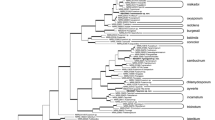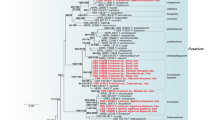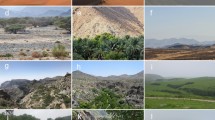Abstract
In an effort to clarify the cause of the deterioration of the colorfully painted murals that adorn the inner walls of the small stone chambers in the Takamatsuzuka and Kitora Tumuli in Japan, we enumerated the fungi that were isolated from moldy spots on the plaster walls collected between May 2004 and April 2005. The 262 fungal isolates from 79 samples of both tumuli were identified as approximately 100 species based on their phenotypic characters. Fusarium, Trichoderma, and Penicillium species were the predominant colonizers in the stone chamber interior and adjacent areas of both tumuli. In addition to the 28S phylogeny, neighbor-joining and Bayesian phylogenies of partial EF-1-alpha gene sequences revealed 24 genetically diverse fusaria in the Takamatsuzuka and Kitora Tumuli. Most of the fusaria were nested in clade 3 of the Fusarium solani species complex (FSSC); however, a few isolates were members of the F. oxysporum species complex (FOSC) clade or the F. avenaceum/F. tricinctum species complex clade. The FSSC isolates were compared with those detected in the Lascaux cave in France. In addition, a partial EF-1α gene phylogeny indicated that 13 Trichoderma isolates clustered in the Harzianum-Virens clade and 5 isolates in the Viride clade or Trichoderma sect. Longibrachiatum. Our analyses suggest that most of the fungi recovered from both tumuli are typically soil dwellers.
Similar content being viewed by others
References
Aoki T, O’Donnell K, Homma Y, Lattanzi AR (2003) Sudden-death syndrome of soybean is caused by two morphologically and phylogenetically distinct species within the Fusarium solani species complex-F. ivirguliforme in North America and F. tucumaniae in South America. Mycologia 95:660–684
Arai H (1984) Microbiological studies on the conservation of mural paintings in tumuli. In: Ito N, Emoto Y, Miura S (eds) Conservation and restoration of mural paintings (1). Proceedings of International Symposium on the Conservation and Restoration of Cultural Properties, November 17–21, 1983, Tokyo, Japan. Tokyo National Institute of Cultural Properties, Tokyo, pp 117–124
Arai H (1987) Microbiological environments and the counterplan for the Takamatsuzuka Tumulus mural paintings (in Japanese). In: National treasures, the Takamatsuzuka Tumulus mural paintings: conservation and repair (in Japanese). The Agency for Cultural Affairs, Japan, pp 186–196
Arai H (1990a) The environmental analysis of archaeological sites. Trends Anal Chem 9:213–216
Arai H (1990b) Biodeterioration of cultural properties and its control. Tokyo National Research Institute of Cultural Properties, Tokyo
Booth C (1966) The genus Cylindrocarpon. Mycol Pap 104:1–56
Chaverri P, Samuels GJ (2002) Hypocrea lixii, the teleomorph of Trichoderm harzianum. Mycol Prog 1:283–286
Chaverri P, Samuels GJ (2003) Hypocrea/Trichoderma (Ascomycota, Hypocreales, Hypocreaceae): species with green ascospores. Stud Mycol 48:1–116
Chaverri P, Castlebury LA, Overton BE, Samuels GJ (2003) Hypocrea/Trichoderma: species with conidiophore elongations and green conidia. Mycologia 95:1100–1140
Ciferri O (1999) Microbial degradation of paintings. Appl Environ Microbiol 65:879–885
Dhawan S, Garg KL, Pathak N (1993) Microbial analysis of Ajanta wall paintings & their possible control in situ. In: Toishi K, Arai H, Kenjo T, Yamano K (eds) Biodeterioration of cultural property, 2. Proceedings of the 2nd International Conference, October 5–8, 1992, Yokohama, Japan. International Communications Specialists, Tokyo, pp 245–262
Domsch KH, Gams W, Anderson T-H (2007) Compendium of soil fungi, 2nd edn. IHW-Verlag, Eching
Dupont J, Jacquet C, Dennetière B, Lacoste S, Bousta F, Orial G, Cruaud C, Couloux A, Roquebert M-F (2007) Invasion of the French Paleolithic painted cave of Lascaux by members of the Fusarium solani species complex. Mycologia 99:526–533
Emoto Y, Emoto Y (1974) Microbiological investigation of ancient tombs with paintings: Ozuka tomb in Fukuoka and Chibusan tomb in Kumamoto (in Japanese). Sci Conserv 12:95–102
Emoto Y, Kadokura T, Kenjo T, Arai H (1983) Surveys related to the preservation of murals in Torazuka ancient burial mound (in Japanese). Sci Conserv 22:121–146
Felsenstein J (1985) Confidence limits on phylogenies: an approach using the bootstrap. Evolution 39:783–791
Gams W (1971) Cephalosporium-artige schimmelpilze (hyphomycetes). Gustav Fischer, Stuttgart
Gams W, van der Aa HA, van der Plaats-Niterink AJ, Samson SA, Stalpers JA (1987) CBS course of mycology, 3rd edn. Centraalbureau voor Schimmelcultures, Baarn
Garg KL, Jain KK, Mishra AK (1995) Role of fungi in the deterioration of wall paintings. Sci Total Environ 167:255–271
Geiser DM, Jiménez-Gasco MM, Kang S, Makalowska I, Veeraraghavan N, Ward TJ, Zhang N, Kuldau GA, O’Donnell K (2004) Fusarium-ID v. 1.0: A DNA sequence database for identifying Fusarium. Eur J Plant Pathol 110:473–479
Gorbushina AA, Petersen K (2000) Distribution of microorganisms on ancient wall paintings as related to associated faunal elements. Int Biodeterior Biodegrad 46:277–284
Graff J (2006) Saving beauty. TIME Europe 167:36–42
Guglielminetti M, Morghen CG, Radaelli A, Bistoni F, Carruba G, Spera G, Caretta G (1994) Mycological and ultrastructural studies to evaluate biodeterioration of mural paintings: detection of fungi and mites in frescos of the Monastery of St. Damian in Assisi. Int Biodeterior Biodegrad 33:269–283
Holden C (2003) Wanted: solution for cave mold. Science 300:245
Huelsenbeck JP, Ronquist F (2001) MRBAYES: Bayesian inference of phylogenetic trees. Bioinformatics 17:754–755
Jaklitsch WM, Samuels GJ, Dodd SL, Lu B-S, Druzhinina IS (2006) Hypocrea rufa/Trichoderma viride: a reassessment, and description of five closely related species with without warted conidia. Stud Mycol 56:135–177
Kigawa R, Sano C, Miura S (2004) Past and present situation of microorganisms in the Takamatsuzuka Tumulus (in Japanese). Sci Conserv 43:79–85
Kigawa R, Sano C, Mabuchi H, Miura S (2005) Investigation of moulds in the Kitora Tumulus during its excavation and restoration works (in Japanese). Sci Conserv 44:165–171
Kigawa R, Mabuchi H, Sano C, Miura S (2006a) Investigation of biological issues in the Kitora Tumulus during its restoration work (2) (in Japanese). Sci Conserv 45:93–105
Kigawa R, Sano C, Ishizaki T, Miura S (2006b) Concept and measures of the conservation of the Takamatsuzuka Tumulus for thirty years and the present situation of biodeterioration (in Japanese). Sci Conserv 45:33–58
Kigawa R, Sano C, Mabuchi H, Miura S (2007) Investigation of biological issues in the Kitora Tumulus during its restoration work (3) (in Japanese). Sci Conserv 46:227–233
Krug JC (2004) Moist chambers for the development of fungi. In: Mueller GM, Bills GF, Foster MS (eds) Biodiversity of fungi: inventory and monitoring methods. Elsevier, Amsterdam, pp 589–593
Kubicek CP, Bölzlbauer UM, Kovacs W, Mach RL, Kuhls K, Lieckfeldt E, Börner T, Samuels GJ (1996) Cellulase formation by species of Trichoderma sect. Longibrachiatum and Hypocrea spp. with anamorphs referable to Trichoderma sect. Longibrachiatum. Fungal Genet Biol 20:105–114
Kumar S, Tamura K, Nei M (2004) MEGA3: integrated software for molecular evolutionary genetics analysis and sequence alignment. Brief Bioinform 5:150–163
Leslie JF, Summerell BA (2006) The Fusarium laboratory manual. Blackwell, Ames, IA
Mantiri FR, Samuels GJ, Rahe JE, Honda BM (2001) Phylogenetic relationships in Neonectria species having Cylindrocarpon anamorphs inferred from mitochondrial ribosomal DNA sequences. Can J Bot 79:334–340
Mau B, Newton M, Larget B (1999) Bayesian phylogenetic inference via Markov chain Monte Carlo methods. Biometrics 55:1–12
Nagatsuka Y, Kiyuna T, Kigawa R, Sano C, Miura S, Sugiyama J (2008) Candida tumulicola and Candida takamatsuzukensis spp. nov., two new yeast species assignable to the Candida membranifaciens clade from the stone chamber of the Takamatsu-zuka Tumulus in Nara Prefecture, Japan. Int J Syst Evol Microbiol (in press)
Novicki TJ, LaFe K, Bui L, Bui U, Geise R, Marr K, Cookson BT (2003) Genetic diversity among clinical isolates of Acremonium strictum determined during an investigation of a fatal mycosis. J Clin Microbiol 41:2623–2628
O’Donnell K (1993) Fusarium and its near relatives. In: Reynolds DR, Taylor JW (eds) The fungal holomorph: mitotic, meiotic and plemorphic speciation in fungal systematics. CAB International, Wallingford, pp 225–233
O’Donnell K (2000) Molecular phylogeny of the Nectria haematococca-Fusarium solani species complex. Mycologia 92:919–938
O’Donnell K, Kistler HC, Cigelnik E, Ploetz RC (1998) Multiple evolutionary origins of the fungus causing Panama disease of banana: concordant evidence from nuclear and mitochondrial gene genealogies. Proc Natl Acad Sci U S A 95:2044–2049
O’Donnell K, Sutton DA, Rinaldi MG, Magnon KC, Cox PA, Revankar SG, Sanche S, Geiser DM, Juba JH, van Burik J-AH, Padhye A, Anaissie EJ, Francesconi A, Walsh TJ, Robinson JS (2004) Genetic diversity of human pathogenic members of the Fusarium oxysporum complex inferred from multilocus DNA sequence data and amplified fragment length polymorphism analyses: evidence for the recent dispersion of a geographically widespread clonal lineage and nosocomial origin. J Clin Microbiol 42:5109–5120
O’Donnell K, Sarver BAJ, Brandt M, Chang DC, Noble-Wang J, Park BJ, Sutton DA, Benjamin L, Lindsley M, Padhye A, Geiser DM, Ward TJ (2007) Phylogenetic diversity and microsphere array-based genotyping of human pathogenic fusaria, including isolates from the multistate contact lens-associated U.S. keratitis outbreaks of 2005 and 2006. J Clin Microbiol 45:2235–2248
Orial G, Mertz J-D (2006) Étude et suivi des phénomènes microbiologiques. Monumental-Dossier les grottes ornées-2006 Semestriel 2:76–87
Posada D, Crandall KA (1998) Modeltest: testing the model of DNA substitution. Bioinformatics 14:817–818
Rannala B, Yang Z (1996) Probability distribution of molecular evolutionary trees: a new method of phylogenetic inference. J Mol Evol 43:304–311
Rossman AY, Samuels GJ, Rogerson CT, Lowen R (1999) Genera of Bionectriaceae, Hypocreaceae and Nectriaceae (Hypocreales, Ascomycetes). Stud Mycol 42:1–248
Saitou N, Nei M (1987) The neighbor-joining method: a new method for reconstructing phylogenetic trees. Mol Biol Evol 4:406–425
Samuels GJ (2006) Trichoderma: systematics, the sexual states, and ecology. Phytopathology 96:195–206
Schroers H-J (2001) A monograph of Bionectria (Ascomycota, Hypocreales, Bionectriaceae) and its Clonostachys anamorphs. Stud Mycol 46:1–214
Seifert KA (1985) A monograph of Stilbella and some allied hyphomycetes. Stud Mycol 27:1–235
Thompson JD, Higgins DG, Gibson TJ (1994) CLUSTAL W: improving the sensitivity of progressive multiple sequence alignment through sequence weighting, position-specific gap penalties and weight matrix choice. Nucleic Acids Res 22:4673–4680
Yli-Mattila T, Paavanen-Huhtala S, Bulat SA, Alekhina IA, Nirenberg HI (2002) Molecular, morphological and phylogenetic analysis of the Fusarium avenaceum / F. arthrosporioides / F. tricinctum species complex: a polyphasic approach. Mycol Res 106:655–669
Zhang N, O’Donnell K, Sutton DA, Nalim FA, Summerbell RC, Padhye AA, Geiser DM (2006) Members of the Fusarium solani species complex that cause infections in both humans and plants are common in the environment. J Clin Microbiol 44:2186–2190
Author information
Authors and Affiliations
Corresponding author
Additional information
First two authors contributed equally to this work
About this article
Cite this article
Kiyuna, T., An, KD., Kigawa, R. et al. Mycobiota of the Takamatsuzuka and Kitora Tumuli in Japan, focusing on the molecular phylogenetic diversity of Fusarium and Trichoderma . Mycoscience 49, 298–311 (2008). https://doi.org/10.1007/s10267-008-0427-3
Received:
Accepted:
Published:
Issue Date:
DOI: https://doi.org/10.1007/s10267-008-0427-3




